You’re looking at your electricity bill and wondering if there’s a better way. Solar batteries have dropped in price while offering more power than ever before. The Tesla Powerwall 3 leads the market with 13.5 kWh of storage, but competitors like Enphase and Franklin bring unique features. Tax credits sweeten the deal. Which battery matches your home’s needs and budget? The answer depends on several key factors.
What Can Home Battery Storage Do For Me?
When the power goes out, your home battery storage kicks in automatically, keeping your lights on and refrigerator running. This backup power means you won’t lose food or sit in the dark during outages.
If you’ve got solar panels, your battery captures extra energy they make. You’ll use this stored power later instead of buying electricity from the utility company. Your battery’s smart too—it releases energy during expensive peak hours when electric rates jump. This saves you money on monthly bills.
During storms or natural disasters, you’re protected. Your battery keeps essential devices running when neighbors lose power. You’ll have electricity for medical equipment, phones, and heating or cooling systems when you need them most.
A solar battery system could also increase home value, offering long-term financial benefits in addition to energy savings.
How the One Big Beautiful Bill Affects Solar Battery Tax Credits
If you’re thinking about getting solar batteries, the One Big Beautiful Bill changes everything. This new law, signed on July 4, 2025, ends the 30% tax credits for solar and solar battery systems after December 31, 2025.
| Timeline | Tax Credit Status |
|---|---|
| Before Dec 31, 2025 | 30% tax credit available |
| After Dec 31, 2025 | No tax credit |
| Current Status | You can still qualify |
| Action Needed | Install before deadline |
You’ll still get the full 30% tax credit if you install your solar battery system before the deadline. The government wants homeowners to move quickly on these installations. Without these tax credits, solar batteries will cost much more starting in 2026. Industry experts suggest talking with energy advisors about your options while there’s still time. One factor to consider is that installation complexity can significantly affect overall costs, adding between $2,000-$5,000 to your investment.
Tesla Powerwall 3: The Market Leader
The Tesla Powerwall 3 leads the home battery market with its 13.5 kWh storage capacity and powerful performance features. You’ll find this best battery delivers 11.5 kW of continuous power and can handle peak loads up to 185 LRA. That’s enough to run most household appliances during outages.
The system achieves 90% round-trip efficiency, meaning you’ll lose just 10% of stored energy during charge and discharge cycles. You can use 100% of the battery’s capacity without damaging it. Tesla backs the Powerwall 3 with a 10-year warranty.
High demand has created long wait times for installations. Many homeowners who want solar and battery systems face delays getting their Powerwall 3 installed. The product’s popularity shows its strong market position.
In addition to home use, solar batteries like the Powerwall are increasingly sought after by small businesses due to their ability to lower energy costs and maintain operations during power interruptions.
Enphase IQ 5P: Modular Power Solution
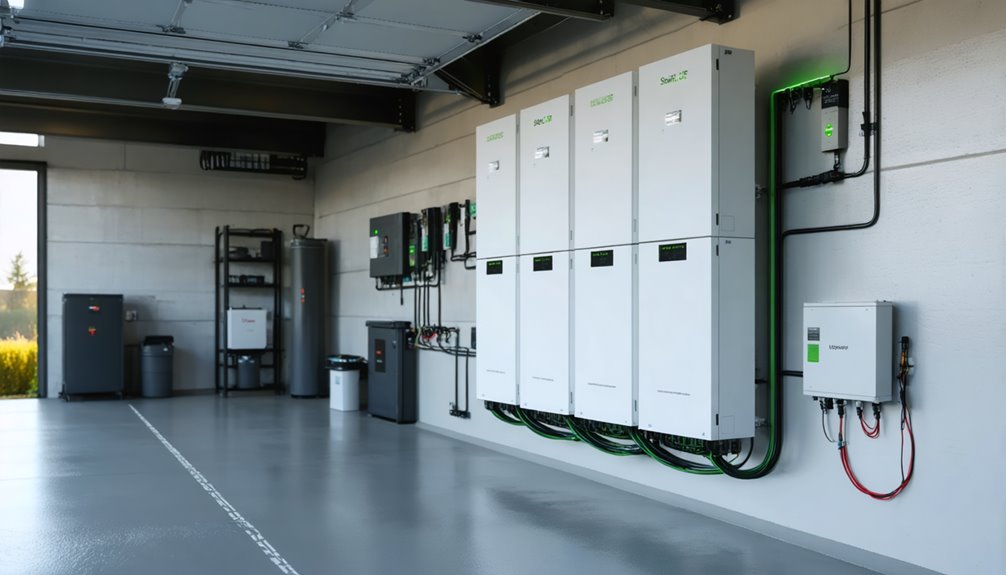
Homeowners looking for flexible battery options can build custom systems with the Enphase IQ Battery 5P. This modular battery system delivers 5 kWh of usable capacity and 3.8 kW of continuous power output. You’ll need at least four units to power your whole home during blackouts. The battery works with Enphase’s IQ8 platform, which helps your solar panels and home energy storage work together smoothly. The system achieves 90% round-trip efficiency and lets you use 98% of its stored energy. However, you’ll need plenty of wall space in your garage since each unit takes up room. The modular design means you can start small and add more batteries later as your energy needs grow. It’s important to consider factors like daily energy consumption and desired days of autonomy during power outages when determining how many batteries you need.
Franklin Apower2: Premium Performance and Design
Nearly twice as powerful as most competitors, the Franklin aPower 2 packs 15 kWh of usable storage into its premium battery system. You’ll get 10 kW of continuous power output with this unit. It can also handle energy spikes up to 15 kW for 10 seconds.
The battery’s premium performance shows in its 89% round-trip efficiency. That means you’ll use most of the energy you store. The sleek design fits well in modern homes. Installation is straightforward, and the system works with various setups.
Franklin backs their aPower 2 with a 15-year warranty. That’s one of the longest in the industry. The large usable capacity makes this battery ideal for bigger homes or anyone who needs extended backup power during outages.
SolarEdge Home Battery: DC-Optimized Efficiency
Smart DC technology sets the SolarEdge Home Battery apart from other options. You’ll find this battery uses DC optimized technology that works directly with your solar panels. It stores 9.7 kilowatt hours of energy and delivers 5 kilowatts of continuous power.
The battery’s hybrid inverter enables DC to DC charging. This means you won’t lose energy through AC conversions. That’s why it’s more efficient than traditional batteries.
When power outages hit, the SolarEdge system lets you prioritize important devices. You can keep your refrigerator and lights running while less critical appliances stay off.
Installation doesn’t require major electrical changes. The battery integrates smoothly with other SolarEdge components. This compatibility creates a unified energy system that’s easier to manage and more efficient overall.
Additionally, the use of a charge controller is crucial to prevent overcharging and ensure the longevity of your battery.
PointGuard Home Battery: Flexible Installation Options
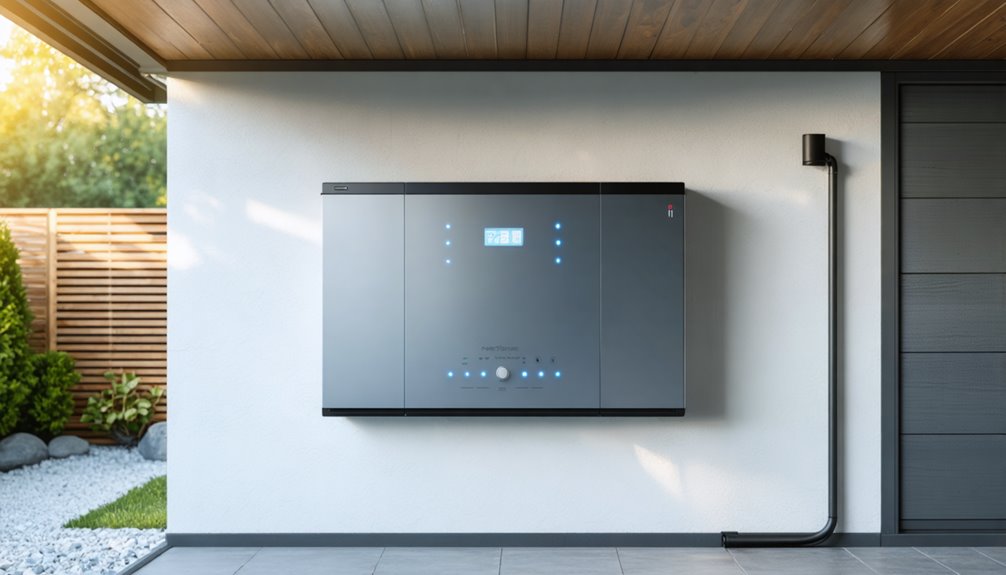
Flexibility defines the PointGuard Home Battery’s approach to storage. You’ll find this system uses modular, stackable parts that adapt to different spaces and needs. The battery’s flexible installation options include both AC and DC coupling, which means it connects easily to existing solar setups or new high-voltage systems. During power outages, the battery’s smart technology chooses which devices get power first. Your essential systems stay on when you need them most. The PointGuard also supports two-way EV charging, letting your electric car work with your home’s energy system. Homeowners can customize the setup based on their specific power needs. This adaptability helps the whole system run more efficiently, whether you’re adding to existing solar panels or starting fresh. Additionally, integrating a storage system provides backup power during outages, ensuring that you maintain access to crucial energy services despite grid failures.
Ac-Coupled Vs Dc-Coupled Battery Systems
When choosing between AC-coupled and DC-coupled battery systems, you’ll notice major differences in how they handle your solar power. AC coupling systems work with your home’s existing AC infrastructure and typically reach 85-90% efficiency. They’re easier to add to current solar setups but need extra inverter equipment.
DC coupling systems connect your solar panels directly to battery storage. They can achieve up to 97.5% efficiency because they skip the AC conversion step. This means you’ll lose less energy during storage and retrieval.
While AC-coupled systems fit better with retrofit installations, DC-coupled ones often perform better in new solar systems. These efficiency differences might seem small, but they’ll add up to significant savings over your battery system’s lifetime.
Understanding Round-Trip Efficiency and Energy Loss
When you store energy in a battery, you’ll lose some of it during the conversion process – that’s where round-trip efficiency comes in. AC-coupled systems typically recover 85-90% of the energy you put in, while DC-coupled systems perform better at up to 97.5%. These efficiency differences might seem small, but they’ll add up to significant energy savings over the years you own your battery system. Factors like battery chemistry and system sizing significantly affect charging speed, influencing overall system efficiency and performance.
Measuring Energy Conversion Rates
Your solar battery’s round-trip efficiency shows how much energy you’ll actually get back from what you store. This percentage tells you how well the system converts power during charging and discharging cycles.
AC-coupled systems typically achieve 85-90% round-trip efficiency, while DC-coupled systems can reach up to 97.5%. These numbers mean you’ll lose some energy during the conversion process. For example, if you store 10 kilowatt-hours in a battery with 90% efficiency, you’ll only get 9 kilowatt-hours back.
The energy conversion rate affects your long-term savings. Higher efficiency percentages mean less wasted electricity and more usable power for your home. Every percentage point matters when you’re relying on stored solar energy during peak hours or outages.
AC Vs DC Efficiency
Two main types of solar battery systems exist today AC-coupled and DC-coupled and they handle electricity differently. You’ll find major differences in their round-trip efficiency rates. AC-coupled systems typically achieve 85% to 90% efficiency, while DC-coupled systems can reach up to 97.5%.
Here’s what happens: AC-coupled systems lose energy during multiple conversions. Solar panels produce DC power, but your home needs AC power. The system converts DC to AC for household use, then back to DC to charge the battery. Each conversion wastes energy.
DC-coupled systems work differently. They charge batteries directly without needing an inverter for conversion. This direct path means less energy loss. Even small efficiency differences matter. They can affect your wallet considerably over time, especially if you’re a heavy energy user.
Real-World Performance Impact
Battery efficiency numbers tell only part of the story. You’ll see different real-world performance based on how you use your battery system. Peak power ratings show what a battery can deliver in short bursts, while continuous output ratings reveal sustained power levels. These numbers matter when you’re running multiple appliances.
Round-trip efficiency differences seem small but add up over time. AC-coupled systems achieve 85-90% efficiency, while DC-coupled systems reach up to 97.5%. That means you’ll lose less energy with DC systems. The Tesla Powerwall 3 and Enphase IQ 5P both hit 90% efficiency.
Depth of discharge also affects performance. Most batteries range from 84% to 100% DoD. Higher DoD means you can use more stored energy before recharging.
Peak Power Vs Continuous Power: What You Need to Know
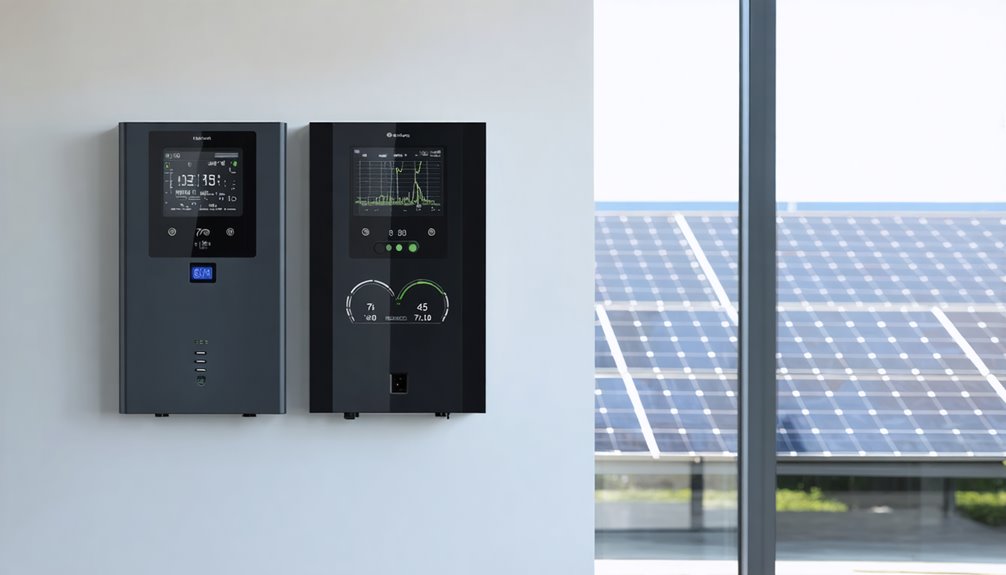
When you’re shopping for a solar battery, you’ll encounter two important numbers: peak power and continuous power. Peak power shows the maximum energy burst a battery can deliver for seconds. Continuous power tells you what it can provide steadily over time.
The Tesla Powerwall 3 delivers 185 LRA peak power and 11.5 kW continuous power. That’s enough to start high-demand appliances. The Enphase IQ 5P offers 7.68 kW peak power for three seconds and 3.84 kW continuous power.
A factor that can significantly influence a solar battery’s performance and lifespan is depth of discharge, which determines how much of a battery’s capacity is used before recharging.
| Battery Feature | Peak Power | Continuous Power |
|---|---|---|
| Heavy Appliances | Critical | Crucial |
| Daily Usage | Helpful | Essential |
| Peace of Mind | Good | Vital |
These metrics matter because many appliances need extra power during startup. Your choice depends on your household’s specific energy needs.
Usable Capacity and Depth of Discharge Explained
You’ll need to understand two key numbers when shopping for a solar battery: usable capacity and depth of discharge. Usable capacity tells you how much energy you can actually pull from the battery, measured in kilowatt-hours (kWh). Depth of discharge (DoD) shows what percentage of the battery’s total capacity you’re allowed to use without damaging it.
Defining Usable Capacity
Although solar batteries advertise impressive total capacities, homeowners can’t actually use every kilowatt-hour stored inside them. Usable capacity refers to the energy you can safely draw from your battery. It’s always less than the battery’s total nameplate capacity.
Here’s why: batteries need to maintain some charge to protect their internal components. The depth of discharge, or DoD, shows what percentage of the battery you can use before recharging. Most modern batteries have a DoD between 84% and 100%.
For example, a 10 kWh battery with 80% DoD gives you 8 kWh of usable capacity. That means you can access 8 kWh for your home’s needs, while 2 kWh stays reserved. Understanding these numbers helps you know exactly how much energy you’ll have available.
Understanding Depth of Discharge
Anyone shopping for a solar battery needs to understand depth of discharge, or DoD. This percentage tells you how much of your battery’s usable capacity you can safely use. Different battery models offer different DoD levels, typically ranging from 84% to 100%.
A higher DoD means you’ll access more stored energy. This can boost your savings and efficiency. Tesla’s Powerwall 3 demonstrates this perfectly. It offers 100% DoD, so you can use all 13.5 kWh of its usable capacity. That’s especially helpful during power outages or when you need extra energy.
Understanding depth of discharge helps you pick the right battery. You’ll know exactly how much power you can actually use from your battery system.
Comparing Battery Specifications
Two key numbers matter most when comparing solar batteries: usable capacity and depth of discharge. Usable capacity tells you how much energy you’ll actually get from a battery. The Tesla Powerwall 3 gives you 13.5 kWh, while the Enphase IQ 5P provides 5 kWh. The Franklin aPower2 offers even more at 15 kWh.
Depth of discharge shows what percentage of the battery you can safely use. Tesla’s Powerwall lets you use 100% of its capacity. The Enphase IQ 5P allows 98% usage. These percentages affect how long your battery will last.
Understanding these specs helps you pick the right battery for your home’s needs. You’ll know if a battery can store enough energy for power outages or peak usage times.
Comparing Solar Battery Warranties and Lifespan
When you’re shopping for solar batteries, you’ll notice manufacturers promise different warranty lengths and performance guarantees. You’ll find warranty periods ranging from 10 to 15 years. Tesla’s Powerwall 3 comes with a 10-year warranty, while Enphase’s IQ 5P offers up to 15 years of coverage.
Battery life depends on several factors. The depth of discharge affects how long your battery lasts. Most batteries let you use 84% to 100% of their capacity. But if you consistently max out usage, you’ll shorten the battery’s lifespan.
Round-trip efficiency also impacts performance. DC-coupled systems achieve up to 97.5% efficiency. Some warranties guarantee your battery will maintain at least 70% capacity by the warranty’s end. This helps you understand what you’re getting long-term.
Proper system configuration plays a critical role in ensuring that solar batteries prioritize solar charging over grid charging, which maximizes system efficiency and cost savings.
How to Match Your Energy Goals With the Right Battery
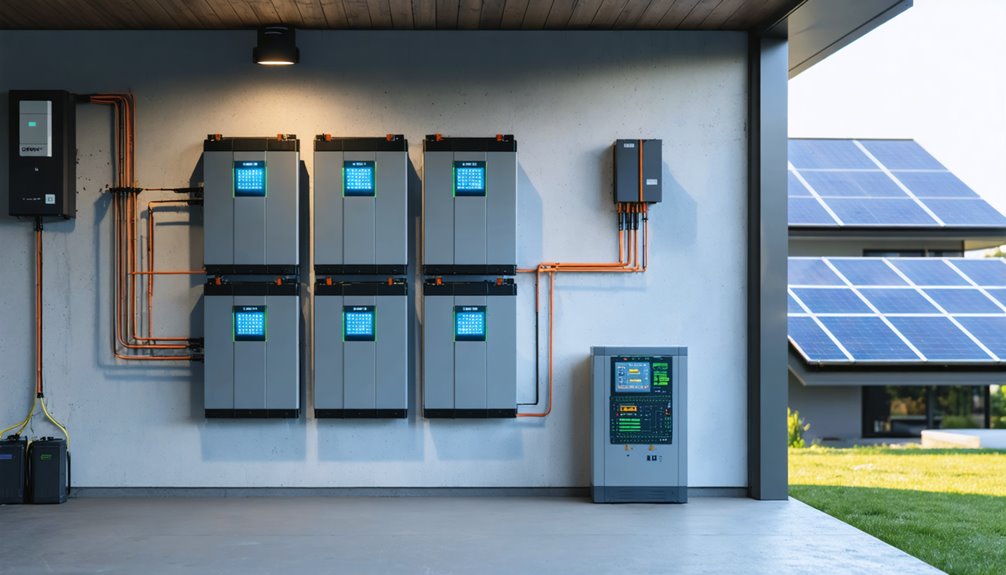
You’ll need to know what matters most to you before picking a solar battery. Some homeowners want backup power when the lights go out, while others focus on saving money by storing extra solar energy. Your personal energy goals will determine which battery specs you should pay attention to, from storage capacity to efficiency ratings. Consider factors such as battery chemistry types, warranty terms, and compatibility with existing solar systems to ensure you make a well-informed decision.
Define Your Energy Priorities
What’s driving your interest in solar batteries? You’ll need to define your energy priorities before choosing the best solar battery for your home. Your main goal shapes everything else about your purchase decision.
You’re likely focused on one of two priorities: backup power during outages or saving money through time-of-use shifting. Each priority requires different battery features and capacities.
If you want backup power, you’ll need enough capacity to run essential appliances during blackouts. The Tesla Powerwall 3’s 13.5 kWh capacity can power most homes for hours. If you’re after cost savings, you might choose a smaller battery like the Enphase IQ 5P with 5 kWh.
Your priority determines whether you need maximum storage capacity or just enough power to shift usage from expensive peak hours.
Match Specs to Goals
Battery specifications matter only if they align with your energy priorities. You’ll need different features for backup power versus daily solar system use.
Here’s how popular battery storage options match different needs:
| Energy Goal | Best Spec Match | Top Battery Choice |
|---|---|---|
| Backup Power | High capacity (13.5+ kWh) | Tesla Powerwall 3 |
| Max Solar Use | High efficiency (90%+) | Enphase IQ 5P |
| Full Access | 100% DoD | Franklin aPower |
| Long-term Savings | 15-year warranty | Enphase batteries |
| Daily Cycling | High efficiency + DoD | Tesla/Enphase |
For backup power, you’ll want high capacity. If you’re maximizing solar self-consumption, efficiency becomes essential. The Franklin aPower2’s 100% depth of discharge means you can use every stored kilowatt-hour. Long warranties protect your investment over time.
Solar Battery Prices and Return on Investment in 2025
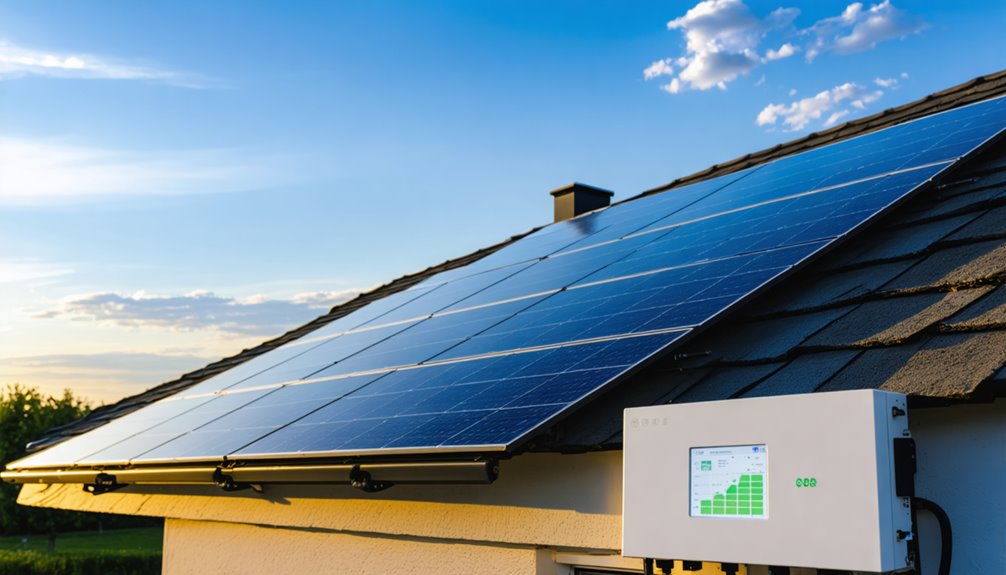
Three major factors are making solar batteries a smarter investment in 2025. First, solar battery prices have dropped considerably in recent years. They’ll likely keep falling through 2025. Second, you can get utility rebates on many systems. These rebates cut your upfront costs and boost your return on investment. Third, there’s a deadline coming up. The 30% federal tax credit expires on December 31, 2025.
You’ll want to know about specific models too. The Tesla Powerwall 3 offers 13.5 kWh of usable capacity. The Franklin aPower2 provides 15 kWh. Both come with 15-year warranties. These long warranties help protect your investment. You can also save money using Time-of-Use shifting. This strategy lets you use stored power when electricity costs the most.
Emerging Technologies and BYOB Programs
You’re seeing major changes in solar battery technology and how you can buy them in 2025. New lithium iron phosphate batteries last longer and work better than older types, while BYOB (Bring Your Own Battery) programs let you pick and install your own battery storage system. These advances connect your battery with solar panels, home energy management, and even electric car charging to create one complete energy system.
New Battery Chemistry Advances
Two major shifts are reshaping the solar battery landscape in 2025. First, new battery chemistry advances are changing how you’ll store solar energy. Lithium iron phosphate batteries are becoming the top choice for homeowners. They’re safer than older battery types and last much longer.
These batteries don’t catch fire as easily. They also work better in hot weather. You can charge and discharge them thousands of times without problems.
Scientists have made the chemistry even better this year. The batteries now hold more energy in smaller spaces. They’re also cheaper to make than before.
Many companies are switching to this technology. Your next solar battery will probably use lithium iron phosphate. It’s quickly becoming the new standard for home energy storage.
BYOB Program Benefits
When you join a BYOB program, you’ll connect your home battery to your utility’s power grid. These programs let you use your own storage systems while earning money. You’ll get rebates or lower electricity rates when you send extra power back to the grid.
The BYOB program benefits include better control over your energy use. You’ll track your battery’s performance through smartphone apps. These apps show when to store power and when to release it. Your participation helps create a cleaner energy grid by supporting renewable energy sources like solar panels.
New battery technologies make these programs work better. Lithium iron phosphate batteries store and release energy efficiently. They’re becoming the preferred choice for homeowners who want energy independence and cost savings through BYOB programs.
Future Storage Technologies
The solar battery industry’s pushing beyond today’s technology to create tomorrow’s energy storage solutions. Scientists are developing solid-state batteries that could transform how you’ll store energy at home. These future storage technologies promise safer, more powerful systems than what’s available now.
Major developments in energy density mean you’ll fit more power into smaller spaces. Lithium iron phosphate chemistry’s already improving battery life. AI-driven systems will soon manage your energy automatically.
| Innovation | Impact | Timeline |
|---|---|---|
| Solid-state batteries | 3x more power | 2-5 years |
| AI energy management | 50% cost savings | Available now |
| Bidirectional EV charging | Your car powers your home | Rolling out |
These breakthroughs aren’t just laboratory experiments. Companies are testing them right now, preparing for widespread release.
Conclusion
You’ve learned about today’s top solar batteries for 2025. The Tesla Powerwall 3 leads with its 13.5 kWh capacity and strong warranty. Enphase’s IQ 5P offers flexibility through modular design. Franklin’s Apower2 delivers premium features. Each battery serves different needs and budgets. New technologies and BYOB programs are changing the market. Battery prices have dropped while tax credits remain available. You’ll find options that match your home’s energy requirements and financial goals.


